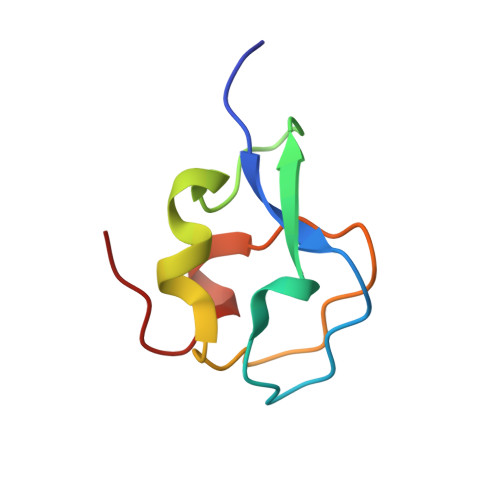Modeling a unit cell: crystallographic refinement procedure using the biomolecular MD simulation platform Amber.
Mikhailovskii, O., Xue, Y., Skrynnikov, N.R.(2022) IUCrJ 9: 114-133
- PubMed: 35059216
- DOI: https://doi.org/10.1107/S2052252521011891
- Primary Citation of Related Structures:
7Q3V - PubMed Abstract:
A procedure has been developed for the refinement of crystallographic protein structures based on the biomolecular simulation program Amber . The procedure constructs a model representing a crystal unit cell, which generally contains multiple protein molecules and is fully hydrated with TIP3P water. Periodic boundary conditions are applied to the cell in order to emulate the crystal lattice. The refinement is conducted in the form of a specially designed short molecular-dynamics run controlled by the Amber ff14SB force field and the maximum-likelihood potential that encodes the structure-factor-based restraints. The new Amber -based refinement procedure has been tested on a set of 84 protein structures. In most cases, the new procedure led to appreciably lower R free values compared with those reported in the original PDB depositions or obtained by means of the industry-standard phenix.refine program. In particular, the new method has the edge in refining low-accuracy scrambled models. It has also been successful in refining a number of molecular-replacement models, including one with an r.m.s.d. of 2.15 Å. In addition, Amber -refined structures consistently show superior MolProbity scores. The new approach offers a highly realistic representation of protein-protein interactions in the crystal, as well as of protein-water interactions. It also offers a realistic representation of protein crystal dynamics (akin to ensemble-refinement schemes). Importantly, the method fully utilizes the information from the available diffraction data, while relying on state-of-the-art molecular-dynamics modeling to assist with those elements of the structure that do not diffract well (for example mobile loops or side chains). Finally, it should be noted that the protocol employs no tunable parameters, and the calculations can be conducted in a matter of several hours on desktop computers equipped with graphical processing units or using a designated web service.
- Laboratory of Biomolecular NMR, St Petersburg State University, St Petersburg 199034, Russian Federation.
Organizational Affiliation:
















